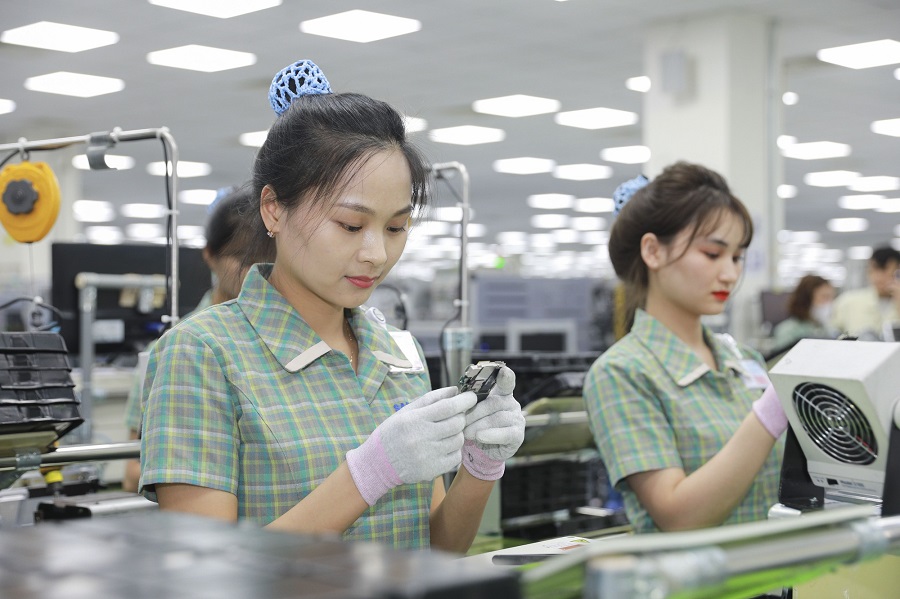Embracing the new wave of investments
Securing sustainable flow of FDIs into Vietnam is a quintessential agenda requiring firmness of attention.

The latest trend observed reveals the prowess of the Greater China markets’ investment flows across diverse sectors and industries. Mixue, a leading bubble tea and ice cream parlor brand, has topped Vietnam’s market with over 1,000 stores; global electronics players such as Luxshare, Geortek, Foxconn, Pegatron, Compal continue to invest heavily into the ecosystem; Hualian Ceramic, a leading household ceramics company, is looking to create a ceramic valley; Sailun Group has made commitments for more investments into their tire manufacturing factory; Lotus Pharmaceuticals has made acquisitions to expand into the pharma industry while Deli Stationery (stationery), Sunwoda (battery), and United Imaging (healthcare) are all making strong inroads into Vietnam.
Vietnam, over the decades, has grown to become tightly intertwined with the global supply chain, advancing into higher value electronics sector and witnessing 7 times growth in exports since 2007, 70% of which are driven by FDI companies. The leading FDI provider over the years has no doubt been Korea, with giant names like Samsung, LG, Hyundai, Lotte, etc. whilst Singapore and Japan have also joined the competition with great success.
However, the dynamics of FDI inflow and the investor landscape is shifting since the second half of 2023 and more evidently coming into 2024. Greater China market flow and predominantly led by Mainland China is increasingly gaining traction. This is on the back of extensive co-mingling of the two economies nudged by the ongoing shift and re-jigging in global supply chain. Trade between the two markets have grown ten-fold from 2007, Vietnam now plays a pivotal role in the downstream segment of China’s manufacturing supply chain, and from a newly registered FDI angle, the Greater China corridors of Mainland China, Hong Kong and Taiwan are collectively contributing to 60% of the aggregate flow compared to 38% in 2022. Additionally, as of first half of 2024, close to 50% of all newly registered FDI investments from the Singapore corridor are also in fact attributed to China and Taiwan investments.
Taiwan, whilst quantum of investment is shadowed by China, continues to expand and deepen into Vietnam as a means to relocate and diversify their supply chains. Taiwan’s 2016 New Southbound Policy has helped to boost the investment flow and Vietnam’s multiple bilateral and regional FTA pacts have catalyzed those global Taiwanese manufacturers to leverage on Vietnam as a cost-effective platform exporting to US, Europe as well as intra-Asia. Today Vietnam is an important and strategic manufacturing outpost for the likes of Foxconn, Compal and Pegatron. Hong Kong is a blend of investors from Hong Kong Corporates to Mainland China firms using Hong Kong as a launch platform to invest into Vietnam.
So why is the Greater China and particularly the Mainland China flow of FDIs expanding? Based on HSBC Global Research, there are several factors.
First, China today stands at the core of global trade where protectionism measures are growing. China’s annual export volume amount to an overwhelming USD3.5 trillion outbeating the US (USD2 trillion) and Germany (USD1.7 trillion). Chinese components are increasingly becoming important for global supply chain. Hence from a global trade corridor perspective, 9 out of the 20 key global trade relations are China centric and only 4 for the US and Europe each. The implication for ASEAN region is a growing trade deficit with China but moreso coming from supply chain re-jigging taking place. ASEAN markets are actually benefiting from import of cheap inputs from China to become competitive and in turn to achieve trade surplus position with the rest of the world. Vietnam is a classic case and one of key beneficiaries.
Second, the investment flows are also a response to growing domestic market backed by the growing middle-income class within the 100 million population where media age is 30 and 70% are working population. China’s #1 EV player, BYD’s recent entry into the market is a testimony.
Lastly, fundamentals continue to remain strong and attractive. Manufacturing wages is less than half of that in mainland China and the 2nd lowest in ASEAN behind Philippines, electricity price is the 2nd lowest in ASEAN just behind Indonesia, diesel price is the 2nd lowest only behind Malaysia. There is significant progress in executing both bilateral and regional FTAs, and in connection FDI Regulatory Restrictiveness Index indicates Vietnam as the most open economy just behind Singapore in the region, whilst the 20% statutory corporate income tax rate reveal comparative advantage against markets such as China, Philippines, Malaysia and Indonesia.
Greater China corridor is and will continue to be rich source of investment buttressing and fueling the country’s growth. FDI flows from other corridors will also contribute. Yet structural headwinds remain. The pace at which these challenges are unraveled will determine the brightness of Vietnam’s future limelight. However, the window of opportunity arising from the global supply chain shift happens to be open to all and not just for Vietnam. The neighboring markets are not bystanders. There are pro investor actions, related laws and decrees as well as measures being implemented by Thailand, Malaysia, Philippines and Indonesia to attract further FDIs. Competition is high.
For Vietnam, criticality lies in advancing forward and climbing further up the value-added chain and also to consummate domestic value-added contents. Exports of consumer electronics remain strong yet Vietnam is behind in global integrated circuits segment, and there are insufficient skilled local technicians to attract hi tech manufacturing investments (albeit the government has recently laid out the roadmap 2050 specifically for the semiconductor sector). But also in other sectors including transport and logistics, infrastructure gap and entailing high logistics cost may weigh down on investment decisions. Green energy and the transition journey require further pace of implementation and digitalization to streamline trade processes will facilitate the ease of business. Concurrently, the ongoing progressive touch to the overarching regulatory framework supporting foreign investments as well as foreign enterprises operating in Vietnam would remain conducive to maintaining Vietnam’s course to receive sustainable investment flows now and into the future.
The message is clear and the opportunity is clearer. Vietnam is favorably positioned to reap the benefit of the global trade diversion and the supply chain alterations. Embracing new investment flows is in the interest of Vietnam and will support the country’s advancement higher up in the value-added ladder across industries and sectors.
HSBC in Vietnam remains an active advocate and steadfast champion of the Vietnam growth story. The strength of the bank’s international network not only enables to support the FDI investors in making successful entry into the market and navigating the various challenges, but also to support the digitalization, working capital optimization and ESG transition needs. Partnering up with Vietnam corporates and facilitating the FDI flow require a dynamic approach. The presence of a Greater China Desk is a direct response to the shifting trends in FDI flow and reflects the adaptable stance of a global international bank.








